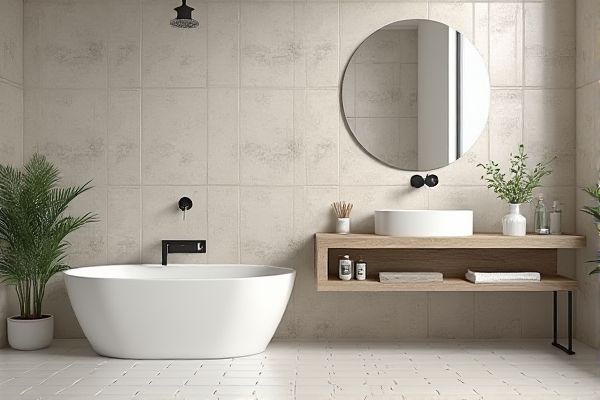
Groutless tile installations offer a sleek, modern look with easier cleaning and reduced risk of mold growth compared to traditional grouted tile, which provides better water resistance and structural integrity in wet areas. Explore the pros and cons of each option to determine which best suits Your space and lifestyle. Read on to learn more.
Table of Comparison
| Feature | Groutless Tile | Grouted Tile |
|---|---|---|
| Installation | Tiles installed edge-to-edge with minimal spacing | Tiles separated by grout lines filled with grout material |
| Maintenance | Easy to clean; no grout to discolor or crack | Requires regular cleaning and sealing to prevent mold, stains, and cracks |
| Aesthetic | Sleek and modern look with seamless appearance | Varied designs through grout color and width; traditional look |
| Durability | Less flexible; tiles may crack if substrate shifts | Grout lines absorb movement, reducing tile breakage risk |
| Cost | Generally higher installation cost due to precision required | Lower installation cost; materials and labor widely available |
| Use Cases | Best for walls, dry areas, and modern designs | Suitable for floors, wet areas, and traditional styles |
Introduction to Groutless and Grouted Tiles
Groutless tiles feature tightly interlocking edges that eliminate the need for grout, creating a seamless and modern look while reducing maintenance and mold buildup. Grouted tiles incorporate grout lines between each tile, providing flexibility in layout, enhanced durability, and the ability to accommodate uneven surfaces. Choosing between groutless and grouted tiles depends on aesthetic preferences, installation complexity, and long-term upkeep requirements.
Key Differences Between Groutless and Grouted Tile
Groutless tiles feature tight-fitting edges that eliminate the need for grout lines, resulting in a seamless and modern appearance with easier maintenance and less susceptibility to mold and mildew buildup. Grouted tiles require filling the spaces between tiles with grout, providing added stability and waterproofing but necessitating regular cleaning and resealing to prevent cracking and discoloration. The choice between groutless and grouted tiles impacts installation complexity, aesthetic appeal, durability, and long-term upkeep requirements.
Aesthetic Appeal: Seamless vs. Traditional Look
Groutless tile offers a sleek, seamless aesthetic that enhances modern interiors by creating an uninterrupted surface, making spaces appear larger and more cohesive. Traditional grouted tile provides a classic look with defined lines that add texture and visual interest, often highlighting individual tile designs. Your choice between groutless and grouted tile will significantly impact the overall style and ambiance of your space.
Installation Process: Ease and Complexity
Groutless tile installation is simpler and faster since it eliminates the need for applying and curing grout, reducing mess and labor time. Grouted tile requires precise grouting and sealing steps, making the process more complex and time-consuming. Your choice depends on whether you prioritize ease of installation or the traditional finish grout provides.
Maintenance and Cleaning Requirements
Groutless tile offers easier maintenance and cleaning since it eliminates grout lines that typically trap dirt, mold, and mildew, reducing the need for frequent scrubbing and sealing. Grouted tile requires regular cleaning to prevent grime buildup in grout joints and periodic resealing to maintain its appearance and durability. Homeowners seeking low-maintenance flooring often prefer groutless tile for its streamlined surface and reduced risk of staining.
Durability and Longevity Comparison
Groutless tile offers enhanced durability by eliminating grout lines that are prone to cracking and discoloration over time, reducing maintenance needs and extending the tile surface's lifespan. Grouted tile, while providing traditional structural support between tiles, requires regular sealing to prevent moisture penetration and grout degradation, impacting its long-term performance. Your choice between groutless and grouted tile should consider the expected wear and environment, as groutless options generally deliver superior longevity with less upkeep.
Cost Analysis: Upfront and Long-Term Expenses
Groutless tile installation typically incurs higher upfront costs due to precise manufacturing and cutting requirements, while grouted tile offers a more budget-friendly initial investment. Over time, grouted tile demands regular maintenance such as grout cleaning, sealing, and occasional repairs, leading to increased long-term expenses. Conversely, groutless tiles reduce upkeep costs owing to the absence of grout lines, resulting in a more cost-effective solution for durability and ease of maintenance.
Water Resistance and Mold Prevention
Groutless tile offers superior water resistance by eliminating porous grout lines where moisture typically accumulates, significantly reducing the risk of water damage and mold growth. Grouted tiles, while providing classic aesthetic appeal, require regular sealing and maintenance to prevent water infiltration and mold formation within grout joints. Choosing groutless tile systems enhances durability in moisture-prone environments such as bathrooms and kitchens by minimizing maintenance and mold-related issues.
Best Applications for Groutless and Grouted Tiles
Groutless tiles are ideal for areas prone to moisture and dirt accumulation, such as kitchens and bathrooms, because they offer a seamless and easy-to-clean surface. Grouted tiles perform best in high-traffic spaces like hallways and commercial floors, where durability and stability are essential due to the reinforced joints. Both applications benefit from the appropriate choice of tile and grout materials to ensure longevity and aesthetic appeal in specific environments.
Choosing the Right Option for Your Space
Groutless tile offers a seamless, modern look with easier cleaning and less maintenance, ideal for small or minimalist spaces where grout lines might disrupt the aesthetic. Grouted tile provides increased stability and enhanced water resistance, making it a strong choice for high-traffic or moisture-prone areas like bathrooms and kitchens. Consider your space's function, style preferences, and long-term upkeep when deciding between groutless or grouted tile to ensure your flooring meets both practical and design needs.
 homyna.com
homyna.com